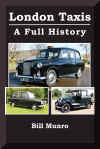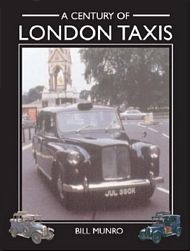| The Birch diesel taxi (images from my father's archive) | |
An interesting story unfolded. As a result of this website, in 2004 I was contacted by Bill Munro (a writer and an historian) who was researching for a book he was then writing "A Century of London Taxis" (published in 2006 - see below) and an article entitled "For Hire" in the February/March 2004 edition of Triumph World magazine (No.54). He kindly sent me details of what was destined to become the first purpose built London taxi with a diesel engine.
Except where noted, all the following information has been provided by Bill Munro; and all images & advertisements have been kindly provided by Derek Pearce and Bill Munro.
John Birch of Birch Brothers (bus/coach and taxi operators based in Kentish Town, North London) operated a fleet of Austin taxis. In 1951 John Birch was engaged in replacing his pre-war cabs with the petrol engined Austin FX3s when he came across the Ferguson tractor diesel engine (which was a conversion from the Vanguard petrol engine). Realising the economic advantages of diesel (the Austin petrol engines gave only 18mpg) he contacted Standard and eventually bought a considerable number of the Ferguson engines to convert his Austin FX3 fleet to diesel.
But Bill believes that John Birch considered the FX3 was too old fashioned, the FX3 having three doors, cart springs, pre-war styling and rod operated brakes (though Bill can find no correspondence to justify this opinion). So although John Birch had converted his own FX3 to diesel power as early as 1952, he went back to Standard and asked them to supply a chassis for a new type of cab to be powered by the Ferguson diesel engine. The chassis for the vehicle (which was a modified Standard Vanguard), was duly delivered to Birch Brothers in December 1953 and immediately passed to Park Royal Vehicles for the bodywork.
Austin developed their own diesel engine for use in the FX3 in late 1954 and thus the FX3D was launched at the 1955 Commercial Motor Show that occurred in the Spring qualifying it as the first 'production' London cab with a diesel motor.
However, the one and only Birch cab (that John intended to call the 'Essbee' from 'Standard and Birch') began working the London streets on the 18th April 1955 and so this establishes the Birch vehicle (SJJ 111) to be the first 'purpose built', diesel powered, London taxi; and, although it was never to go into full production, it was the first cab with four doors to be licensed in London.
And
this is the very taxi for which my father, Alfred Hill, designed the bodywork!
The layout was unconventional, in that three passengers sat on the rear seat and the fourth sat alongside the driver facing rearwards. This required the luggage compartment, hitherto placed next to the driver, to be consigned to a rear compartment accessed by a full height nearside door. Other unusual features for the time were the absence of a nearside front door and a roof mounted 'For Hire' sign. Despite the strange layout, a Commercial Vehicle Test carried out by Modern Transport magazine seemingly praised the 'Bold Design of the Birch Taxicab' for its 'improved appearance, comfort and economy' (Modern Transport Magazine article on the Birch Taxi).
Although there was an aim to put the vehicle into production, sadly only the one prototype was built (PRV Body No. B38707 Ed.). Standard changed to unit construction, and that was at least one reason for the taxi's unfortunate abandonment. Another reason was the eventual arrival of the Austin FX4 that was a more modern vehicle, despite some arguable faults.
Being a prototype for evaluation purposes the Birch taxi was only intended to operate for six months. Despite this it stayed in service for four years, following its license by the PCO in December '55, after which it became the inspector's (Les Sales) vehicle based at Birch Bros. Henlow Camp garage.
0----------0----------0----------0----------0
Bob Bayman writes: I have just stumbled on your website by chance, looking up references for John Birch. The taxi is of great interest to me as I worked at Birch Bros. for a few months after leaving school in 1967 and once drove this machine, ferrying it from Kentish Town to Hatfield to hand over to Les Sales, the Inspector at Henlow Camp, who used it as a staff car. Until finding your site I had not realised the cab body was by Park Royal; interesting indeed!
I was eighteen then so unable to drive buses, though I did drive most of Birch Bros.' service fleet at one time or another (perhaps the worst being their Standard Atlas van). I was pretty enthusiastic when I was asked to take the cab up the road after it had been at the Kentish Town depot for routine servicing.
At the time I drove it, it was all-over dark blue; somewhere between royal and navy as I recall (as noted by Hans-Bertil Ekström above, ED.), and to my eternal regret I didn't take any photos!
It was quite an adventure to drive! It had a steering-column gear change which was as sloppy as one would expect (or at least as I anticipated, having recently taken a similarly equipped elderly Bedford CA van to the Alps with my mates a few weeks before). I recall that the cab might have been three-speed, but that may not be true at all. However, all went well until I stopped in traffic on Barnet Hill (very much home territory for me), and when the traffic moved on I couldnít find any gears at all. It seemed like for ever, though in reality it was probably only for a few seconds; but I was certainly red faced. It wouldnít have been so bad if the cab itself wasnít already causing heads to turn. I had noticed very quickly that it attracted stares all the way and a couple times people were about to cross the road in front of me, but changed their minds when they saw what it looked like. That was even before leaving Kentish Town!
It was with a mixture of disappointment and relief that I handed it over to Les at Hatfield.
I can still recall his chuckling at my tales of the brief adventure.
(My thanks to Bob
Bayman for his interesting anecdote Ed.).
0----------0----------0----------0----------0
Here
are two books by Bill
Munro that both detail the Birch taxi. |
||

|
Londonís taxis are famous around the world, as much a part of the capital as the red buses, Big Ben and Buckingham Palace. Their story is a long and fascinating one, with constant challenges to the makers, owners and dealers |
London Taxis a Full History ISBN: 978-0-9574754-2-7 © Earlswood Press (March 28th 2014) |
 |
Currently out-of-print but click the the details to the right to search Google. |
A
Century of London Taxis ISBN: 1861267622 |
More Websites |
||
Visit the London Vintage Taxi Association Web Site |
||
| Site dedicated to "Independent Operators" | ||
| Peter Gould's original "Local Transport Histories" Site | ARCHIVED | |